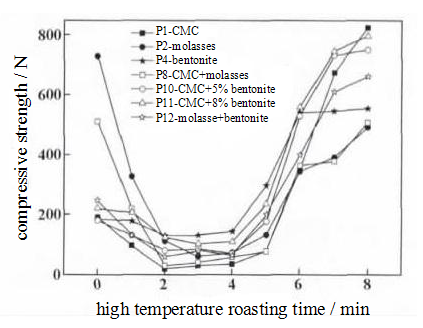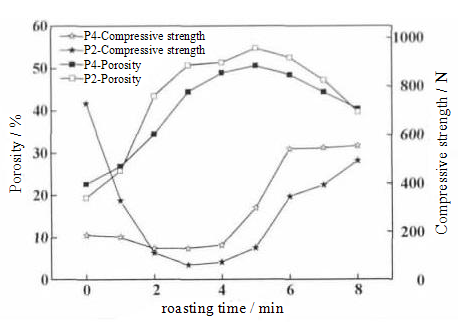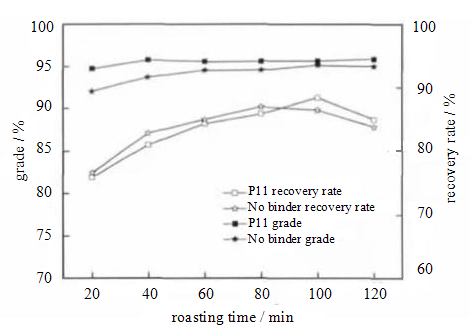Effect of binder on the strength of carbonaceous briquette from high iron tailings
Since the tailings are very fine in size, it is more reasonable for the raw tailings to be pelletized followed by direct reduction roasting. In order to investigate the possibility of iron recovery by direct reduction roasting of carbon briquette from high iron tailings, the effects of different binders on the green briquette strength and high temperature strength of carbon briquette from high iron tailings were studied.
1. Test materials and properties
The raw material used in the experiment was high speed iron tailings with total iron grade of 32.87%. The main additives in the test are inner coal blending and binder. The moisture content, ash content, volatile content and fixed carbon content of inner blending coal were 11.77%, 19.90%, 28.18% and 51.92%, respectively, and crushed to -1 mm.
2. Test method
The raw ore, inner coal and binder are mixed by a certain quality, and then a certain quality fraction of water is added to stir and mix, and then carbon pellet is obtained by pressing the briquette press.
Perform the following experiments:
a. High temperature strength measurement.
b. Determination of green pellet strength: including the drop times and compressive strength of wet and dry briquettes.
After determining the best binder for pellet, low intensity magnetic separation test of direct reduction roasting-grinding was carried out to obtain the final direct reduction iron product
3. Test Results
3.1 Effect of different binders on the strength of briquette
A certain amount of raw ore is mixed with 20% inner coal, an appropriate amount of water and different kinds of binders for briquette pressure test, and the results are shown in Table 1.
Table 1 Pellet ratio and green briquette strength with single binder
Code No. | Water volume% | Binder | Amount of binder% | No. of wet drops(times·50cm-1) | Wet-bulb compressive strength/N | No. of dry drops(times·50cm-1) | Dry compressive strength/N |
P1 | 14.4 | CMC | 0.4 | 4.2 | 40.56 | 4.2 | 191.8 |
P2 | 2.7 | molasses | 15 | 3.0 | 23.44 | >20 | 730.00 |
P3 | 15.6 | starch | 10 | 3.2 | 47.00 | 6.7 | 142.8 |
P4 | 13 | bentonite | 10 | 7.6 | 43.78 | 5.5 | 186.00 |
P5 | 11.7 | Water glass | 10 | 1.8 | 18.8 | 1.7 | 45.52 |
P6 | 15.6 | Refractory cement | 10 | 1.0 | 30.00 | 1.0 | 20.5 |
P7 | 15.6 | standard cement | 10 | 1.5 | 47.90 | 4.5 | 146.00 |
Table 1 shows that CMC has the most significant effect on improving briquette drop and compressive strength, and the dosage is only 0.4% of raw ore ; followed by bentonite and soluble starch, and the green briquette strength basically reaches the requirement when its dosage is 10% of the original ore; other binders do not meet the requirement.
3.2 Effect of composite binder on the strength of green briquettes
Different proportions of CMC and molasses, standard cement, bentonite, as well as molasses and bentonite as composite binder were used for briquette compression test, and the test results are shown in Table 2.
Table 2 Performance of briquettes with composite binder
| Code No. | Water volume% | Binder and binder dosage% | Binder and binder dosage (times·50cm-1) | Wet-bulb compressive strength/N | No. of dry drops(times·50cm-1) | Dry compressive strength/N |
| P8 | 12 | 0.4%CMC+8%molasses | 7.6 | 31.8 | >20 | 511.8 |
| P9 | 15.4 | 0.4%CMC+8%standard cement | 3.7 | 63.67 | 3.0 | 164.9 |
| P10 | 15.0 | 0.4%CMC+5%bentonite | 9.4 | 41.88 | 13.0 | 181.00 |
| P11 | 15.4 | 0.4%CMC+8%bentonite | 10.6 | 45.68 | 14.3 | 222.2 |
| P12 | 12.5 | 5%molasses+5%bentonite | 4.6 | 22.56 | >20 | 248.5 |
3.3 Effect of roasting on the strength of briquettes
According to the results of the above study, briquettes P1, P2, P4, P8, P10, P11 and P12 with the required strength were selected and their high-temperature strengths were measured, and the results are shown in Fig. 1. The results are shown in Fig. 1. The trend of strength change during high-temperature roasting with different binder ratios is basically the same, with the compressive strength of the briquettes decreasing at the beginning of roasting and gradually increasing at the later stage.
Fig. 1 Effect of high temperature roasting time on the high temperature strength of briquettes

The previous results can be concluded that, in terms of energy consumption and roasted ore grade, the amount of additives should be minimized while ensuring the quality of the briquettes, so 0.4% CMC plus 8% bentonite is used as the best binder for this mine.
3.4 Effect of briquette porosity on pellet strength
As shown in Figure 2, the porosity of carbon briquette increased first and then decreased with the roasting time. Combined with the study on the change of intensity during the reduction process of oxidized briquette, the rapid decrease of intensity at the initial stage of roasting of carbon briquettes was caused by the increase of porosity inside the briquettes .
Figure 2 Variation of pellet porosity at different times of high temperature roasting

3.5 Direct reduction roasting magnetic separation test of briquette
After determining the briquettes P11 as the best formulation, they were subjected to direct reduction roasting-magnetic separation tests. The binder-free pellets were used as a control test to investigate the effect of binder on the direct reduction roasting and magnetic separation of the briquettes. As can be seen from Figure 3, the trend of the two briquettes with roasting time is basically the same, with the increase of roasting time, the grade of the direct reduction iron product does not change much; the recovery rate shows a trend of first increasing and then slowly decreasing.
Fig. 3 Effect of roasting time on direct reduction index of pellets

4. Conclusion
4.1 When using a single binder, CMC and bentonite have better effect on improving the strength of green briquettes; Molasses has a remarkable effect on improving the strength of dry briquettes.
4.2 When using compound binder, the best ratio of compound binder is 0. 4%CMC +8% bentonite.
4.3 There was a great difference in the compressive strength of dry briquettes with different binders, but the change trend of the compressive strength was basically the same at high temperature roasting. The compressive strength of briquettes decreased rapidly at 0 ~ 2 min in the initial roasting stage, and gradually increased at 4 ~ 8 min.
4.4 The decrease of the strength of carbon briquette during the initial calcination period of 0 ~ 2 min is caused by the increase of the porosity inside the briquette. During 5 ~ 8 min, the iron particles bonded to each other and the compressive strength of briquette was improved due to the formation of iron phase in briquette.
4.5 After pelletizing with the best binder ratio, magnetic separation test of direct reduction roasting was carried out. Under the condition of roasting temperature 1200℃ and roasting time 100 min, total iron grade 95.64% and recovery 88.42% were obtained.




